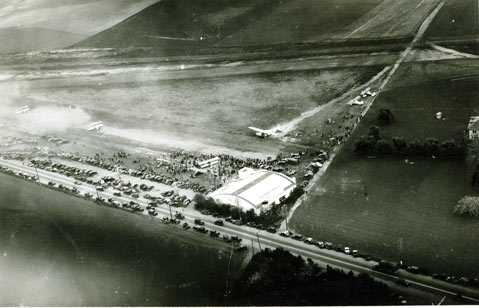The Flying Bauhaus Brothers
Early Aviation Pioneers

There have been a number of important figures in early aviation history with a South Coast connection. Among the most significant were the flying Bauhaus brothers. The oldest brother, born in 1884, was Frank.
The Bauhaus family owned a large farm in Indiana, and Frank’s father was also a skilled carpenter and a barrel-maker — skills that his sons would later put to good use. Frank took his first flight in a balloon in 1902, and his fascination with flying was born. Upon leaving the farm, Frank traveled around the country before arriving in San Francisco, where he worked construction in the aftermath of the great 1906 earthquake and fire. It was while in California that Bauhaus met Lincoln Beachey, who taught him to fly in a Curtiss pusher biplane. In 1914, he would serve as Beachey’s mechanic when the stuntman performed in the skies over Hope Ranch.
Visiting friends in Carpinteria, Frank met blacksmith Dick Morris, who offered him space in his shop to open a carpentry and construction business. The business went well, and in 1917, he was joined by brothers William, Louis, and Jack. All four were bitten by the aviation bug, and they determined to build their own airplane.
Their first plane was of a fairly standard design, and the brothers sold it to a firm in Oakland. Their next machine, christened the B-3, was something altogether different. Unlike the square-bodied, somewhat bulky shape of many planes of the period, the B-3 sported a sleek, cigar-shaped fuselage. Taking a note from their barrel-maker father, the plane’s frame was made of lightweight spruce, put together like barrel staves and finished with plywood and canvas. The plane’s weight of 1,100 pounds was almost half that of the Jenny, one of the most popular planes of the time. The climbing rate of 1,000 feet in 10 minutes was excellent for the era.
The first test flight, April 28, 1920, was a rousing success, and the enthusiastic crowd christened the new plane the “Flying Keg.” Tests continued, and on May 23, pilot Ira Fuller took the plane up three times. On the third flight, William and Louis joined him. The load was too much, and a hard banking turn became an uncontrollable spinout. The crash killed William, and Louis sustained serious injuries. Ironically, the crash also proved the great strength of the fuselage design, and by October, another plane was completed. Sadly, the fatal May 23 crash would not be the last suffered by these aviation pioneers; Louis later lost his life in the skies over Santa Barbara’s Samarkand neighborhood.
Accidents were not the only misfortunes that plagued the brothers. When applying for a patent, they were informed by an attorney representing a Frenchman that his client already had a patent for that design. The brothers later discovered the same attorney also represented the company that built Lindbergh’s Spirit of St. Louis, which incorporated a similar barrel-like design. Did the builders of one of the most famous planes in history take a page from the Bauhaus design manual? In any case, commercial success was not in the cards for the Bauhaus brothers.
For a time, Carpinteria became an important center of aviation, due in no small part to the Bauhaus legacy. Carpinteria Airport opened in 1928 and was the largest airport in this area until being superseded in the early 1930s by what is today Santa Barbara Municipal Airport. Although perhaps not as well-known as some of their contemporaries, the Bauhaus brothers were major pioneers in aviation.



